Sheldon Treasures Before Sheldon
January–May 2023
Learning Guide

January–May 2023
Learning Guide
January–May 2023
The city of Lincoln has had an organization dedicated to collecting and exhibiting art since 1888, when a University of Nebraska art teacher formed the Haydon Art Club. The club’s first major acquisition was made in 1896. Haydon Art Club was soon renamed the Nebraska Art Association and is today known as the Sheldon Art Association. It and the University of Nebraska are the pillars of this museum’s collection. Significant works acquired in the organization’s first seven decades include paintings by Edward Hopper, Norman Rockwell, and Mark Rothko.
To celebrate the first two thousand entries into the collection, we have assembled a selection of historic acquisitions made prior to the opening of the museum’s current building in 1963.
Exhibition support is provided by Assurity, Kim Robak and William Mueller, Sutton Dermatology + Aesthetics, and Union Bank & Trust
Springfield, OH 1898–Monson, ME 1991
Cliff and Ferry Street
Gelatin silver print, 1935
University of Nebraska–Lincoln
Allocation of the U.S. Government, Federal Art Project of the Works Progress Administration
U-1856.1943

San Francisco, CA 1902–Monterey, CA 1984
Zabriskie Point, Death Valley National Monument, California
Gelatin silver print, circa 1942
University of Nebraska–Lincoln
Anna R. and Frank M. Hall Charitable Trust
H-509.1958
EDWARD WESTON
Highland Park, IL 1886–Carmel-by-the-Sea, CA 1958
Pepper
Gelatin silver print, 1930

University of Nebraska–Lincoln
Anna R. and Frank M. Hall Charitable Trust
H-516.1958
From 1935 to 1943, the US government— through the Works Progress Administration’s Federal Art Project—provided artists with a weekly salary to create works that took on the “American Scene.” Through this program, the university was gifted over 200 works including 55 photographs that became the foundation for the museum’s photography collection. Norman Geske, Sheldon’s first director from 1956 to 1983, continued to significantly build the collection, which now includes over 2,800 photographs.


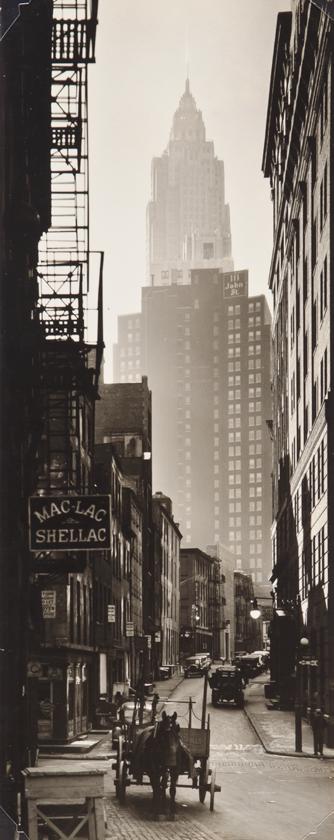 BERENICE ABBOTT
Cliff and Ferry Street
ANSEL ADAMS
Zabriskie Point, Death Valley National Monument, California
EDWARD WESTON Pepper
BERENICE ABBOTT
Cliff and Ferry Street
ANSEL ADAMS
Zabriskie Point, Death Valley National Monument, California
EDWARD WESTON Pepper
Columbus, OH, 1882–New York, NY 1925
Tin Can Battle, San Juan Hill, New York
Crayon, ink, and charcoal on paper, 1907
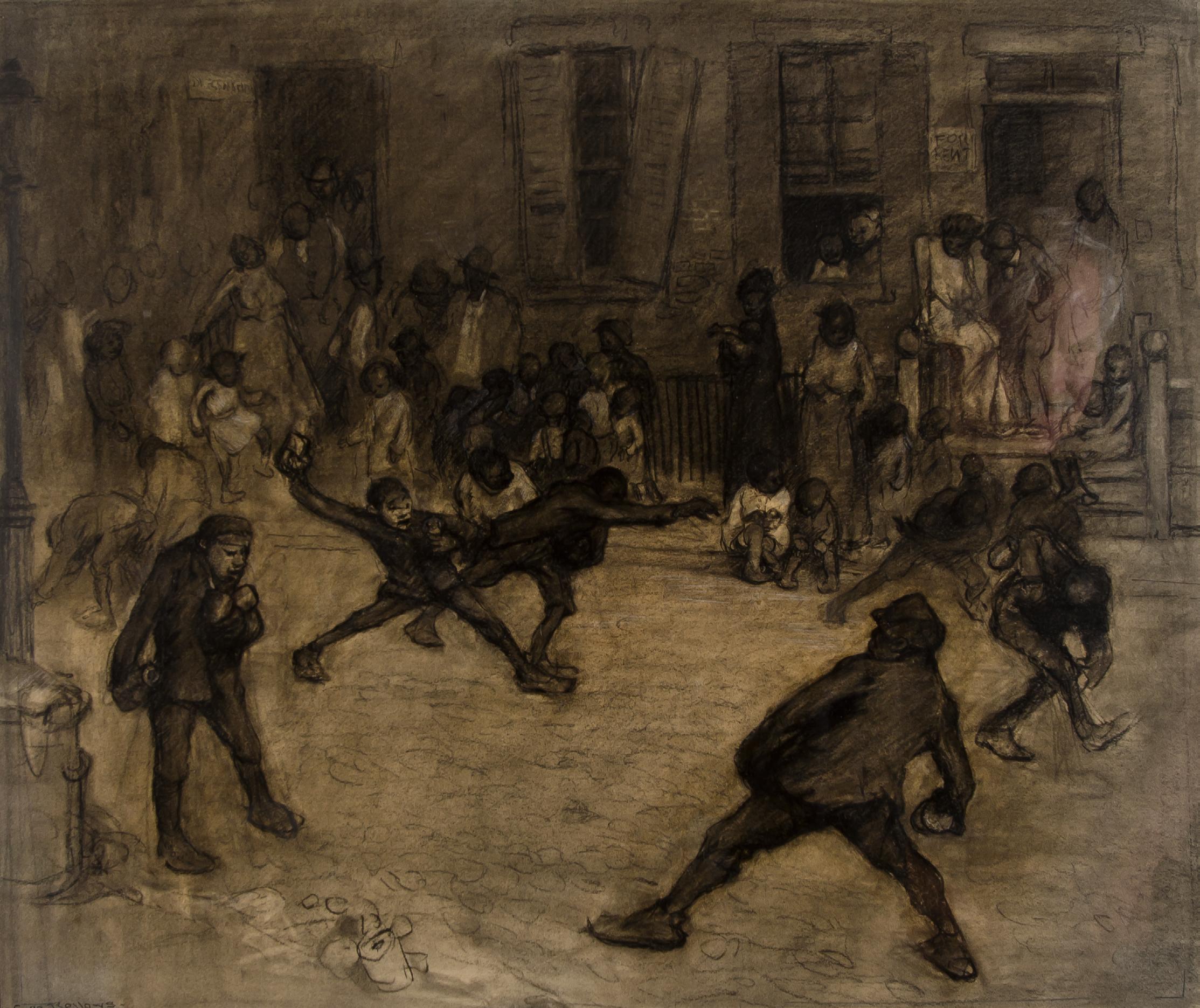
University of Nebraska–Lincoln
Anna R. and Frank M. Hall Charitable Trust
H-272.1947
When Ohio-born George Bellows moved to New York City in his early twenties, he was captivated by the city’s crowds and the cacophony that surrounded him. His paintings and drawings from that time show his interest in scenes in densely populated tenement areas. San Juan Hill, a neighborhood a few blocks northwest of Bellows’s studio apartment in midtown Manhattan, was a predominately Black, Puerto Rican, and Italian area with racial and ethnic tensions that occasionally made newspaper headlines. Bellows’s use of charcoal and ink in this work create a dark, sooty atmosphere and emphasize San Juan Hill’s impoverished conditions. The neighborhood was designated a slum in the 1940s, and, in an early example of urban gentrification, was later razed to build Lincoln Center.
 Tin Can Battle, San Juan Hill, New York
Tin Can Battle, San Juan Hill, New York
Neosho, MO 1889–Kansas City, MO 1975
Lonesome Road
Tempera on Masonite, 1927

Nebraska Art Association Collection
N-39.1935
Thomas Hart Benton first sketched this scene on a summer day in 1926 while leaning out of a train car at an Arkansas railroad crossing. The driver’s downcast expression and the crucifixlike telephone pole in the background hint at a troubling nostalgia for the long-suffering, deeply religious Black culture of the Old South. This painting, completed a year later, is an evocative example of Benton’s search for quintessential American characters that, through its title, also gives a nod to music of the period. “The Lonesome Road” is a 1927 ballad, written in the style of an African American folk song, that enjoyed widespread popularity.
 THOMAS HART BENTON Lonesome Road
THOMAS HART BENTON Lonesome Road
Smarhoń, Russian Empire (now Belarus) 1906–New Milford, CT 1992
The White Factory
Oil on canvas, 1928

Nebraska Art Association
Nelle Cochrane Woods Memorial N-98.1957
Peter Blume, like many precisionist painters in the 1920s, took modern developments in American industry as his subject matter.
Here The White Factory rises up from its surroundings, its prominent, crisply rendered smoke stack a vision of the future. The rectilinear building towers over darker, more ramshackle structures that symbolize the past and have been haphazardly grouped in a way that defies strict perspectival logic.
 PETER BLUME
The White Factory
PETER BLUME
The White Factory
STUART DAVIS

Philadelphia, PA 1892–New York, NY 1964
Arch Hotel
Oil on canvas, 1929
University of Nebraska–Lincoln
Anna R. and Frank M. Hall Charitable Trust
H-268.1947
Paris was old fashioned, but modern as well . . . There was so much of the past and the immediate present brought together on one plane that nothing seemed left to be desired. There was a timelessness about the place that was conducive to the kind of contemplation essential to art. And the scale of the architecture was human.
—Stuart Davis, 1931
Stuart Davis painted Arch Hotel when he lived in Paris between 1928 and 1929. He had carefully studied the city and its architecture through a number of sketches he made while looking out the windows of cafés in the Montmarte neighborhood. In Arch Hotel , Davis reduces the buildings to broad planes of color and dramatically flattens the three-dimensional space, revealing his own understanding of European modernism. He also merges cityscape and still life by including objects on his café table in the composition; lemon and rum are the ingredients of a drink he especially favored during the cold Parisian winter.
 STUART DAVIS Arch Hotel
STUART DAVIS Arch Hotel
Lancaster, PA 1883–Lancaster, PA 1935
Backdrop of East Lynne
Tempera on board, 1919
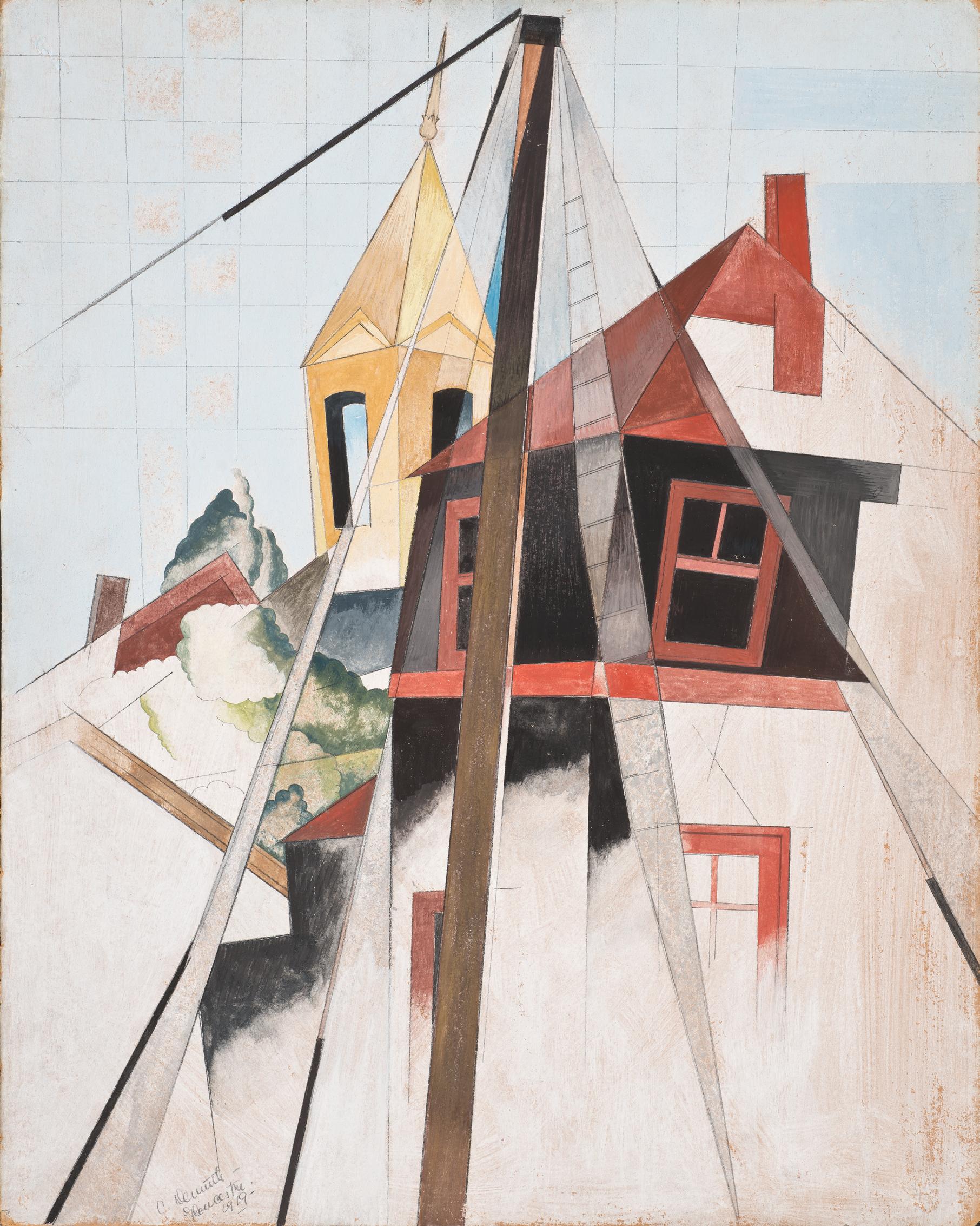
University of Nebraska–Lincoln
Anna R. and Frank M. Hall Charitable Trust
H-261.1946
Since the late nineteenth century, the small seaside town of Gloucester, Massachusetts, served as an artist colony during the summer. In Backdrop of East Lynne , Charles Demuth paints the cream-colored belltower of the town’s First Baptist Church as viewed through a boat’s riggings. By 1919, the artist had begun to refine his precisionist cityscapes by switching from watercolor to tempera on board to achieve crisper lines and planes of color. The title of this work had eluded many until recently, when scholars tied it to a melodramatic 1861 novel, East Lynne , that had several stage and screen adaptations in the early twentieth century.
 Backdrop of East Lynne
Backdrop of East Lynne
Berlin, Germany 1893–West Berlin (now Berlin), Germany 1959
Funeral in Paris
Ink and watercolor on paper, 1924

University of Nebraska–Lincoln
Anna R. and Frank M. Hall Charitable Trust
H-248.1944
Considered a satirist of his time, George Grosz caricatured Weimar Germany’s ruling elite and documented the rise of Hitler and the Nazi party in his political cartoons. He was one of several avant-garde artists who fled to the United States from Europe before the start of World War II. Grosz drew Funeral in Paris during a brief spring sojourn in France, where he reconnected with friends and visited brothels and cafés. The drawings from this trip, which included sketches of the city’s streets and daily happenings, are far less biting and more introspective than the devastation he captured later during periods of war.
 GEORGE GROSZ
Funeral in Paris
GEORGE GROSZ
Funeral in Paris
CHILDE HASSAM
Boston, MA 1859–East Hampton, NY 1935
Fifth Avenue, April Morning 1917
Watercolor on paper, 1917

University of Nebraska–Lincoln
Anna R. and Frank M. Hall Collection
H-38.1928
Fifth Avenue, April Morning 1917
I painted the flag series after we went into the war. There was that Preparedness Day, and I looked up the avenue and saw these wonderful flags waving, and I painted the series of flag pictures after that.
—Childe Hassam, 1927On May 13, 1916, New York City held a parade along Fifth Avenue to commemorate the beginning of US military involvement in the European conflict, which later became World War I. The “Preparedness Parade” lasted almost thirteen hours and included more than 137,000 marchers. During the remaining years of the war, Childe Hassam applied his signature impressionist style to street scenes that emphasized the flags dotting the city. According to its title, this painting was done in the month—April of 1917—that the United States officially declared war. In addition to American flags, it features the flags of Britain and France, two countries that allied with the United States.

BARBARA HEPWORTH
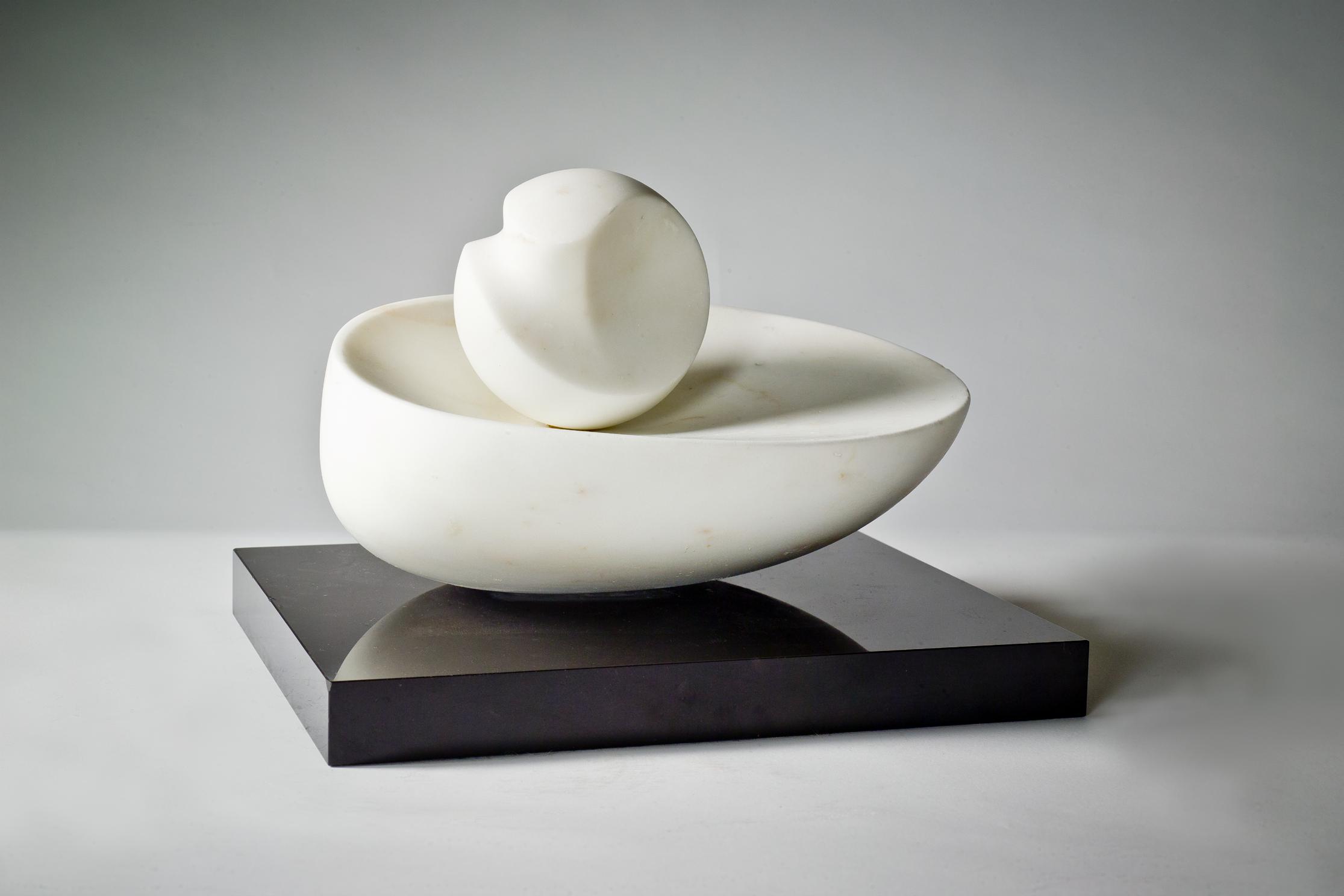
Wakefield, United Kingdom 1903–St. Ives, United Kingdom 1975
Small Form Resting
Seravezza marble, 1945
Nebraska Art Association
Thomas C. Woods Memorial N-112.1959
Small Form Resting
Rather than making preparatory drawings or models to guide her work, sculptor Barbara Hepworth allowed her sculptures to emerge organically from their materials. The ovoid shapes in Small Form Resting were likely inspired by rock formations near Hepworth’s home in St. Ives, Cornwall, on the southwestern coast of England.

EDWARD HOPPER

Upper Nyack, NY 1882–New York, NY 1967
Night Shadows
Etching, 1921, published 1924
University of Nebraska–Lincoln
Anna R. and Frank M. Hall Charitable Trust
H-333.1951
After I took up etching, my paintings seemed to crystalize.
—Edward Hopper, 1955Edward Hopper’s period of printmaking—1915 through the 1920s—influenced his economic approach to composition as well as to his dramatic treatment of light and shadow. He purchased a press for his studio in 1916, which allowed him to experiment with printing and work prolifically. Hopper’s voyeuristic interests while riding the city’s elevated trains led to several works like Night Shadows that depict lone subjects from unusual vantage points. This print was published as part of a portfolio titled Six American Etchings , which included works by fellow New York realists Peggy Bacon, John Marin, and John Sloan.
 EDWARD HOPPER
Night Shadows
EDWARD HOPPER
Night Shadows
Okayama, Japan 1889–New York, NY 1953
Room 110
Oil on canvas, 1944

University of Nebraska–Lincoln
Anna R. and Frank M. Hall Charitable Trust
H-252.1945
Yasuo Kuniyoshi heightened the peculiarity of his paintings by employing skewed perspectives and applying oil paint thickly. By the 1930s, he began to paint from real life while preserving hints of his earlier imaginative, off-kilter compositions. Room 110 won first prize in the Carnegie Institute’s juried exhibition Painting in the United States, 1944 , and was acquired by the University of Nebraska shortly thereafter. For this painting, the artist arranged disparate objects— including an umbrella, newspaper, grapes, a vase attached by string to a piece of unidentifiable detritus, and a red shirt—on top of a tipped-up side table. Overall, the effect is amusing and surreal.
 YASUO KUNIYOSHI
Room 110
YASUO KUNIYOSHI
Room 110
Castleford, United Kingdom 1898–Perry Green, United Kingdom 1986
Family Group
Bronze, 1947

University of Nebraska–Lincoln
Anna R. and Frank M. Hall Charitable Trust
H-314.1951
British sculptor Henry Moore distilled his subjects to their most basic, universal forms while retaining visual comprehension. His studies of natural shapes—bones, shells, pebbles—which he believed were subconsciously understood by everyone, make up the visual language he applied to sculpture. In the late 1940s, Moore began a series of “family group” sculptures, which vary in scale and composition. Originally commissioned as a large sculpture for a progressive elementary school in England, this work’s family group reflected the school’s philosophy that a child’s parents were integral to their educational experience.
 HENRY MOORE Family Group
HENRY MOORE Family Group
ROBERT MOTHERWELL

Aberdeen, WA 1915–Provincetown, MA 1991
Hotel Flora
Oil on Masonite, 1950
University of Nebraska–Lincoln
Anna R. and Frank M. Hall Charitable Trust
H-310.1951
When Robert Motherwell first exhibited Hotel Flora in 1950, he called it “a capriccio.” Describing the word—used by musicians to mean a free-form, often fantastic composition—he stated, “the subjects are the classical ones of twentieth-century Parisian abstract painting: figures, interiors, still lifes. The fantasy is brutal and ironical.” This painting and two other capriccios in the 1950 exhibition depicted similar interiors of a seemingly fictional hotel.
 ROBERT MOTHERWELL Hotel Flora
ROBERT MOTHERWELL Hotel Flora
Sun Prairie, WI 1887–Santa Fe, NM 1986
New York, Night
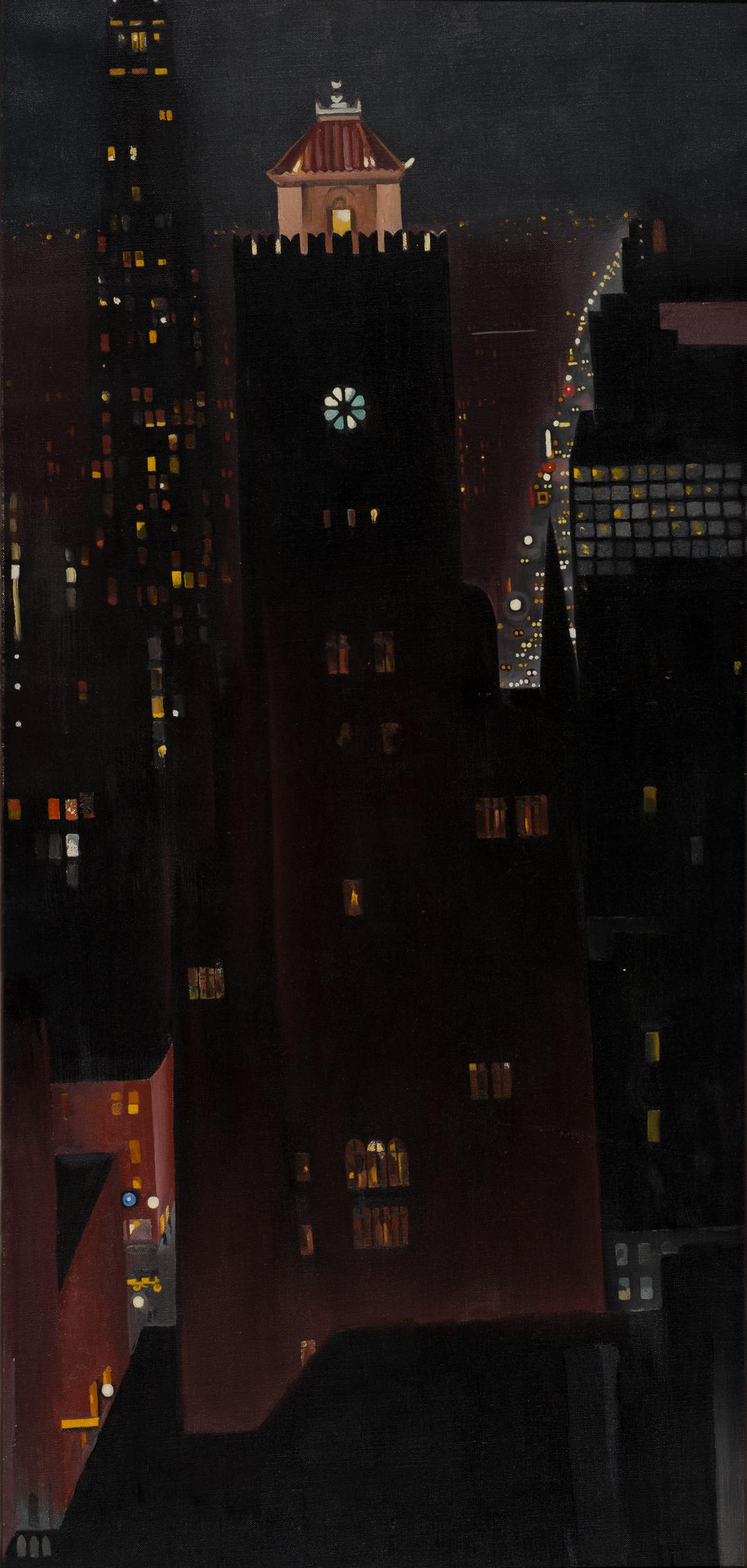
Oil on canvas, 1928–1929
Nebraska Art Association
Thomas C. Woods Memorial N-107.1958
Lexington Avenue looked, in the night, like a very tall, thin bottle with colored things going up and down inside it.
Georgia O’Keeffe based this glittering, nocturnal view of New York City on what she saw from the north-facing, 30th-floor window of her studio in the 1,200-room Shelton Hotel—a then-brand-new skyscraper north of Grand Central Terminal where she lived with her husband, photographer Alfred Stieglitz. Both artists drew inspiration from their studio views of the city. Most notable in this painting is the Beverly Hotel, identifiable by its distinctive rosette window. In 1958, the Nebraska Art Association (now Sheldon Art Association) acquired New York, Night from its annual invitational exhibition, making it part of Sheldon’s collection.
 GEORGIA O’KEEFFE New York, Night
GEORGIA O’KEEFFE New York, Night
WAYNE THIEBAUD

Mesa, AZ 1920–Sacramento, CA 2021
Salads, Sandwiches, and Desserts
Oil on canvas, 1962
Nebraska Art Association
Thomas C. Woods Memorial N-138.1962
Apart from my formal interest, what also interests me about all foods are the varying material substances . . . Meringue is much easier for me to talk about because as a substance it is so sensuously appealing . . . [Meringue and marshmallows] are sticky and drippy and very close to the consistency of oil paint.
—Wayne ThiebaudCalled “the poet laureate of the coffee break” by an art critic, Wayne Thiebaud burst into the New York art scene with his nostalgic depictions of diner fare. The Nebraska Art Association (now Sheldon Art Association) purchased this painting from the relative newcomer in 1962, shortly after his first New York solo show. Due to restrictions of the Thomas C. Woods Memorial Fund, the acquisition had to be endorsed by two qualified persons who would state for the record that Thiebaud was “an artist whose work is worthy of a museum purchase.” For this requirement, then-director Norman Geske reached out to the director of the Wadsworth Atheneum in Connecticut, which had also purchased a Thiebaud painting from his solo show, and the director of the Des Moines Art Center, who had requested to borrow Salads, Sandwiches, and Desserts for a traveling exhibition.
 WAYNE THIEBAUD
Salads, Sandwiches, and Desserts
WAYNE THIEBAUD
Salads, Sandwiches, and Desserts
Anamosa, IA 1891–Iowa City, IA 1942
Arnold Comes of Age (Portrait of Arnold Pyle) Oil on pressed board, 1930
Nebraska Art Association Collection N-38.1931

Arnold Comes of Age (Portrait of Arnold Pyle)
Grant Wood gained national recognition in 1930 after his enigmatic painting American Gothic won the Art Institute of Chicago’s Norman Walt Harris bronze medal and was later reproduced on the front page of the Chicago Evening Post . The following year, the Nebraska Art Association (now Sheldon Art Association) purchased Arnold Comes of Age (Portrait of Arnold Pyle) directly from the native Iowan for three hundred dollars after Wood’s visit to Lincoln. This painting commemorates the twenty-first birthday of Wood’s studio assistant and former art student Arnold Pyle.
